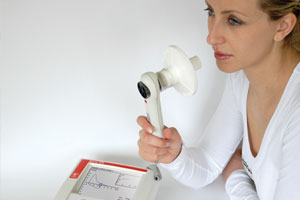MAKING spirometry more accessible for patients and more financially rewarding for GPs is vital to improving the diagnosis of chronic obstructive pulmonary disease in Australia, according to a GP expert.
Professor Nick Zwar, professor of general practice in the School of Public Health and Community Medicine at the University of NSW, said poor financing of spirometry in general practice was a major inhibitor to the recognition and diagnosis of chronic obstructive pulmonary disease (COPD).
He was commenting on a new report in the latest MJA from the Burden of Obstructive Lung Disease (BOLD) study, which set out to measure the prevalence of COPD among Australians aged 40 years and older. (1)
The 1620 men and 1737 women in the study were randomly selected from the electoral roll between 2006 and 2010 and answered standardised questionnaires. Forced expiratory volume in 1 second (FEV1), forced vital capacity (FVC), and the FEV1/FVC ratio were also measured by spirometry, before and after bronchodilator administration.
The researchers found that the prevalence of COPD (classified according to the Global Initiative for Chronic Obstructive Lung Disease criteria as Stage II or higher) was 7.5% among people aged 40 years and older and 29.2% in people 75 years and older.
The prevalence was at the lower end of the international range (8.5%–22.2%) for Australian men at 6.9% and in the middle range for women (3.7%–16.7%) at 8.1%.
The authors wrote that due to “poor utilisation of spirometry in primary care settings and the largely silent nature of the disease in its early stages, COPD is under-recognised by doctors and underreported by patients”.
Professor Zwar said better access to spirometry was vital to obtaining accurate COPD prevalence figures.
“Access to spirometry is one of the things we need to improve, absolutely”, Professor Zwar said. “How to do that is the question.
“To do spirometry well is time-consuming and requires skills. It takes an investment of time and energy to get and maintain those skills”, he said.
“The other issue is how to finance spirometry in a primary care setting. The current Medicare rebate is a pittance and that needs to be addressed.”
With the current Medicare rebate at just $17.50, the issue for GPs was one of outcome versus time and effort invested, Professor Zwar said.
“Is there enough demand for spirometry to justify training a practice nurse? Is that the best use of a practice nurse’s time?” he asked.
An editorial in the same issue of the MJA suggested that local hospital networks and Medicare Locals could offer innovative approaches to treating people with chronic conditions, such as developing systems for optimal practice. (2)
The authors wrote that hospitals and Medicare Locals could look at spirometry services available in their area and “develop and promote innovative approaches that increase the availability of easily accessible spirometry, as has been done in the Netherlands”.
Professor Zwar said that the system used in the Netherlands — where patients go to specialised centres for spirometry and results are interpreted online by a panel of respiratory specialists before being forwarded to the referring GP — was one option worth considering in Australia.
“We could do something like that here via pathology providers, for example”, he said. “Maybe we need a variety of models, including the use of Medicare Locals.
“This conversation has been going on for some years but we haven’t actually found a solution.
“It needs the Medicare Locals and advocates to take this on as an issue that needs to be resolved. The RACGP, Lung Foundation, Thoracic Society — all need to get together and come up with a model or models that can be presented to government, because it’s going to need some government funding”, Professor Zwar said.
“In terms of monitoring COPD, there is no evidence that spirometry is of much benefit. But in terms of diagnosing COPD, it is the gold standard.”
– Cate Swannell
1. MJA 2013; 198: 144-148
2. MJA 2013; 198: 124-125
Posted 18 February 2013

 more_vert
more_vert
Too right that the spirometry MBS rebate is a pittance.
We do have a well trained practice nurse and doctors able to perform and interpret spirometry , and we have a quality and calibrated spirometer.
However, due to the offensively low rebate we hardly use it unless the patient can pay privately – if we do it for people who cannot afford it privately, it is an act of charity.
Haven’t other recent GP studies shown that nearly 50% of COPD diagnoses are incorrect? Although that is also an argument for widespread use of spirometry.